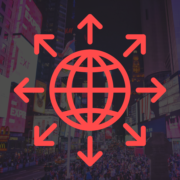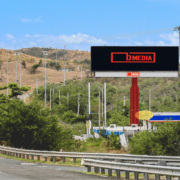In today’s constantly changing advertising world, business owners often face the dilemma of selecting the most effective method to advertise their products or services. The available options range from digital platforms to traditional print media. To make an informed decision, it is essential to understand each medium’s strengths and weaknesses thoroughly. This is where an in-depth “Analysis of Billboard Advertising vs. Other Media” can prove invaluable.
Billboard advertising, a stalwart of traditional marketing, offers unique advantages that can complement or even outshine newer media in certain contexts. As we delve into this analysis, we aim to equip you, the business owner, with the knowledge needed to discern whether billboard advertising aligns with your marketing objectives and budget.
Our journey through this comparison will highlight key factors such as cost, reach, engagement, and overall effectiveness. By considering these aspects, you can make a strategic decision that elevates your brand’s visibility and maximizes your return on investment.
Stay as we explore the nuances of billboard advertising and how it stacks up against other media options. Whether you’re a seasoned marketer or new to the advertising game, this analysis will give you a clear, expert perspective on making your next campaign a resounding success.

Understanding Billboard Advertising
When we talk about billboard advertising, we’re referring to one of the oldest forms of marketing that continues to hold its ground in the digital age. This section aims to shed light on what billboard advertising entails, its key benefits, and when it’s most effective for businesses like yours.
- Definition and Types: Billboard advertising is a form of outdoor advertising that uses large-scale print advertisements to capture the attention of passersby in high-traffic areas. There are several types, including traditional billboards, digital billboards, and mobile billboards, each offering unique advantages depending on your campaign goals.
Key Benefits
- High Visibility: Billboards are placed in strategic locations, offering high visibility to a diverse audience. This ensures that your message reaches a wide range of potential customers.
- Brand Awareness: The sheer size and presence of billboards make them excellent tools for building brand awareness. They provide repeated exposure to your advertisement, helping your brand stay top of mind.
- Targeted Advertising: While digital platforms offer targeted advertising based on user data, billboards can target geographic locations, reaching potential customers in specific areas where your service or product is most relevant.
Ideal Scenarios for Effectiveness:
- Launching New Products or Services: When introducing a new product or service, billboards can create a significant impact, quickly spreading the word across a broad audience.
- Promoting Time-Sensitive Events: For events or sales with a specific timeframe, billboards can effectively communicate your message to a large audience in a short period.
- Enhancing Local Presence: For businesses looking to strengthen their presence in a particular locality, billboards can reinforce local brand recognition and customer loyalty.
Understanding these aspects of billboard advertising is crucial for business owners contemplating this traditional yet impactful advertising medium. By aligning your advertising strategy with billboards’ unique benefits, you can leverage their potential to achieve your marketing objectives effectively.
Comparing Billboard Advertising with Digital Media
In the digital era, advertising strategies have evolved to include a myriad of online platforms, from social media to pay-per-click (PPC) campaigns. However, understanding how billboard advertising measures up against these digital alternatives is crucial for making informed decisions. Let’s explore the pros and cons of billboard advertising versus digital media, focusing on cost-effectiveness and audience reach.
Overview of Digital Media Advertising
- Social Media: Platforms like Facebook, Instagram, and LinkedIn offer targeted advertising based on user demographics, interests, and behaviors.
- PPC: Pay-per-click advertising, often associated with search engines like Google, allows businesses to pay only when a user clicks on their ad.
- Email Marketing: Directly reaching out to potential or current customers through email, tailored to their interests or past behaviors.
Pros and Cons
- Billboard Advertising:
- Pros: High visibility, broad geographic reach, and continuous exposure to a wide audience.
- Cons: Less targeted compared to digital ads, fixed location, and potentially higher upfront costs.
- Digital Media:
- Pros: Highly targeted, measurable results, and flexible budgets. Allows for real-time adjustments based on ad performance.
- Cons: Can be easily overlooked due to ad saturation online, requires constant optimization, and potential privacy concerns for users.
Cost-effectiveness and Audience Reach Comparison:
- Billboard Advertising: Offers a one-time cost for a fixed period, providing continuous exposure to anyone passing by the billboard. Ideal for reaching a broad audience in specific locations.
- Digital Media: Costs can vary widely based on the campaign’s scale, targeting specifics, and competition for ad space. While potentially more cost-effective for targeting specific demographics, digital campaigns require ongoing investment to maintain visibility and engagement.
For business owners, the choice between billboard and digital media advertising should be guided by your campaign goals, target audience, and budget. If your aim is to build brand awareness in a specific geographic area or to make a bold statement with a new product launch, billboard advertising might offer the visibility and impact you need. Conversely, if your focus is on highly targeted advertising with measurable outcomes and the flexibility to adjust campaigns in real time, digital media advertising could be the more appropriate choice.
Balancing the strengths of both billboard and digital media can often lead to the most effective advertising strategy, leveraging the broad reach and visibility of billboards with the targeted, interactive nature of digital campaigns.
Billboard Advertising vs. Print Media
This “Analysis of Billboard Advertising vs. Other Media” section shows how traditional advertising has long been a staple for businesses looking to reach potential customers. This includes newspapers, magazines, flyers, and brochures. However, as we explore the nuances of billboard advertising compared to print media, it’s essential to understand their distinct characteristics and how they can serve different marketing objectives.
Brief on Print Media Advertising:
- Newspapers and Magazines: Offer targeted reach within specific interest groups or communities. Ideal for detailed content and local advertising.
- Flyers and Brochures: Cost-effective for local distribution, providing detailed information about products or services.
Comparison of Longevity, Visibility, and Audience Engagement:
- Billboard Advertising:
- Longevity: Billboards typically have a longer display period, ranging from a few weeks to several months, providing sustained visibility.
- Visibility: High-impact visuals in high-traffic areas ensure that billboards are seen by a wide audience, including those who may not actively seek out your advertisement.
- Audience Engagement: While billboards excel in capturing attention, they offer limited space for detailed information, focusing instead on brand awareness and call-to-action.
- Print Media:
- Longevity: Newspapers and magazines have a shorter lifespan, often read once then discarded.
- Visibility: Print ads can target specific demographics but require the audience to purchase or subscribe to the medium.
- Audience Engagement: Offers the opportunity for more detailed information, appealing to readers already interested in the content.
Cost Comparison and Situational Advantages:
- Billboard Advertising: Generally involves higher upfront costs due to production and space rental. However, it’s highly effective for broad message dissemination and brand visibility in specific geographic areas.
- Print Media: Costs can vary widely based on circulation, ad size, and the publication’s popularity. It effectively targets niche markets or local communities with detailed messages.
Choosing between billboard and print media advertising hinges on your campaign’s goals, budget, and desired audience. Billboards are unmatched in their ability to make a bold statement and generate widespread brand awareness quickly. In contrast, print media offers a more intimate connection with the audience, suitable for conveying detailed information and reaching specific interest groups.
Integrating both mediums could provide a comprehensive approach for business owners—using billboards for broad visibility and brand awareness, complemented by print ads to delve deeper into the details of your offerings. This strategy ensures that your message not only reaches a wide audience but also engages them on a more personal level.

Billboard Advertising vs. Broadcast Media
When considering the broader spectrum of advertising mediums, broadcast media—encompassing television and radio—presents a dynamic platform for reaching audiences. This section delves into how billboard advertising compares with broadcast media in terms of audience reach, engagement, costs, and selecting the appropriate medium based on campaign goals.
Overview of Broadcast Media
- Television (TV): Offers a wide reach and the ability to convey messages through visual and auditory elements, making it highly engaging for a diverse audience.
- Radio: Provides auditory advertising opportunities, ideal for reaching listeners during specific times, such as commute hours, with the advantage of targeting by geographic and demographic factors.
Comparative Analysis on Audience Reach, Engagement, and Costs:
- Billboard Advertising
- Audience Reach: Billboards have a constant presence in high-traffic areas, ensuring visibility to a broad, diverse audience.
- Engagement: While billboards capture attention quickly, the engagement is brief, relying on impactful visuals and succinct messages.
- Costs: Involves a one-time production cost and a recurring fee for the advertising space, potentially offering a better cost-per-impression due to its continuous exposure.
- Broadcast Media:
- Audience Reach: Both TV and radio have extensive reach, with TV offering national exposure and radio providing more localized targeting.
- Engagement: High, especially with TV, due to the combination of visual and audio elements that can tell a compelling story.
- Costs: Generally higher, especially for TV, due to production costs and airtime fees. Radio can be more affordable but still requires production and slot booking investment.
Choosing the Right Medium Based on Campaign Goals:
- Billboard Advertising: Ideal for building brand awareness and promoting location-based or event-specific campaigns. It’s especially effective for businesses seeking to make a visual impact and establish a presence in specific geographic areas.
- Broadcast Media: Best suited for campaigns aiming to reach a wide audience with engaging stories or messages that require audio-visual elements. TV is perfect for national campaigns, while radio is excellent for local or regional targeting.
B owners must decide between billboard and broadcast media based on their marketing objectives, target audience, and budget. Billboards are an excellent choice for reinforcing brand presence and messaging, due to their constant visibility in chosen locations. On the other hand, broadcast media has a broader reach and dynamic storytelling capabilities, making it a powerful tool to evoke stronger emotional responses and audience engagement.
Maximizing the Impact of Billboard Advertising
For business owners contemplating the integration of billboard advertising into their marketing mix, understanding how to maximize its impact is crucial. This section provides actionable tips for creating effective billboard ads, integrating these with other media for enhanced results, and measuring the success of billboard advertising campaigns.
Tips for Creating Effective Billboard Ads:
- Keep It Simple: The most impactful billboards feature clear, concise messaging. Aim for a strong, simple visual and limit your text to six words or fewer.
- Make It Memorable: Use bold, contrasting colors and creative visuals that stand out to make your billboard memorable.
- Focus on Location: Choose locations that not only offer high traffic but also reach your target demographic effectively.
- Include a Call-to-Action: Whether it’s a website, phone number, or a social media handle, make sure your call-to-action is easy to remember.
Integrating Billboard Advertising with Other Media
- Cross-Promotion: Use billboards to complement digital campaigns by echoing the messaging or promotions running on social media, email, or your website. This creates a cohesive brand experience across multiple touchpoints.
- QR Codes and Hashtags: Incorporate QR codes or hashtags into your billboard design to bridge the gap between offline and online engagement, making it easy for viewers to connect with your brand on digital platforms.
- Event and Launch Support: Utilize billboards to build anticipation for product launches or events, directing audiences to online channels for more information.
Measuring the Success of Billboard Advertising Campaigns
- Brand Awareness Surveys: Conduct surveys before and after your billboard campaign to measure changes in brand recognition and perception.
- Traffic and Sales Analysis: Monitor website traffic, in-store visits, and sales data during the campaign period to identify any spikes that correlate with your billboard advertising.
- Engagement Metrics: Track engagement on digital platforms if your billboard includes elements like QR codes or hashtags, providing direct insight into the campaign’s digital impact.
Maximizing the impact of billboard advertising requires a blend of creative strategy, thoughtful placement, and integration with other marketing efforts. By focusing on clear, memorable messaging and leveraging the synergy between billboard and digital media, businesses can create powerful, multi-dimensional campaigns that resonate with their target audience.
As we conclude this “Analysis of Billboard Advertising vs. Other Media” remember that the effectiveness of your advertising efforts hinges on aligning your chosen mediums with your overall marketing objectives and audience preferences. With the right approach, billboard advertising can be a key component of a successful, comprehensive marketing strategy, driving visibility, engagement, and ultimately, business growth.

Final Advice
Every advertising medium has its own set of advantages and disadvantages. To decide between billboard advertising and other forms of media, such as digital, print, or broadcast, one must thoroughly comprehend their business’s marketing goals, target audience, and financial restrictions.
Billboard advertising stands out for its ability to offer high visibility, broad geographic reach, and a lasting impression on a wide audience. It builds brand awareness and complements marketing campaigns to establish a strong presence in specific locales or alongside major thoroughfares. However, its effectiveness is maximized when integrated thoughtfully with other advertising mediums, leveraging the detailed targeting of digital media, the storytelling power of broadcast media, and the niche appeal of print media.
Finally, it’s important to remember that the most successful advertising strategies are adaptable, integrated, and aligned with your brand’s core values and objectives. Whether you’re a small local business or a large multinational corporation, incorporating billboard advertising and other media can significantly enhance your marketing efforts and contribute to your overall business success.










 787 792 4113
787 792 4113
